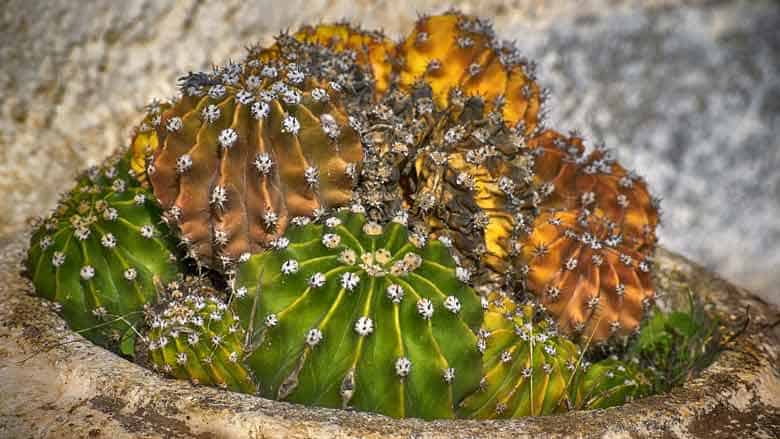You may be wondering what a sunburned cactus is and how you can identify it.
Sunburns are a common issue for many people, but a sunburned cactus or succulent is not something you would expect.
What is a sunburned cactus? It’s a physical condition that affects many cacti and succulents. It’s when the skin on your cactus plant has been damaged by too much sun exposure. Sunburned cacti often have brown or black patches and can be bruised as well.
Below I will discuss how to identify, treat, and prevent sunburn in your plants so that they stay healthy.
What Causes Sunburn on Cacti?
Sunburn on a cactus can happen when there’s too much direct sunlight for an extended period of time without protection from structures like trees or taller plants to block some of the bright light and provide shade.
This usually happens during summer days when temperatures are high and intense radiation levels are present because they cause extreme heat stress, damaging cells.
When this happens, your plant will show signs such as wilting leaves, yellowing stripes on newer growths near the top where new leaves emerge from stem, or browned tips with curled edges showing the damage done to older parts of the plant near the base.
What Does Sunburn Look Like on a Cactus?
The color of the sunburn is a sign that you might have over-exposed your cactus to sunlight.
A sunburned cactus will turn from its natural greenish-gray shade to an orange, red, or even bright yellow if it has been exposed for too long.
Sometimes a sunburn can be so severe as to make the top layer of dry skin peel off and reveal new layers underneath. This type of sunburnt plant may appear white where there are no living cells below anymore.
The sunburn affects all parts of a cactus, even those low on the ground. These parts cannot get any protection like sturdier plants would be able to do with taller structures between them and direct light.
The sunburn affects the color of all parts of a cactus, but it is most prevalent in the green skin that protects them.
Common signs of a sunburned cactus are:
- The sunburned skin will be lighter than before they were in direct sunlight. This can lead to parts of the cactus appearing yellow or brown, but this is not always true
- A sunburn may cause some patches on the green skin that seem discolored from their original color
- Some cactuses might have sunburns all over them if they sit close enough to each other for one plant’s shade to affect another. Even those plants without protection against direct bright light because they’re too low and get little coverage from taller structures.
- The whole plant could look like it has just been doused with water – drooping at its joints and wilting overall – as well as have a sunburned appearance
- The plant will be dehydrated and could even start to shrivel up because of the sun damage, so proper care must be given.
Can a Cactus Recover From Sunburn?
A sunburned cactus will eventually recover and start to grow back, but it takes a lot of time.
In the meanwhile, it’s essential to provide special care until the sunburn is gone.
If the sunburn is bad enough, then the whole plant could die because of dehydration or other complications such as mold growth.
How Do You Treat a Sunburned Cactus
When your plants get a sunburn, you mustn’t let them suffer for too long and neglect their care because they need special treatment right away.
It is recommended that you first provide extra shade by covering up or bringing indoors when necessary, so protection is provided outside during those hot periods (if possible).
Next, water your plant more than usual in the afternoons and evenings.
Finally, provide some shade by placing a tree, shade cloth, or piece of cardboard over it to reduce sun exposure during peak hours.
How To Heal a Sunburn Cactus
A sunburned cactus is a common result of the plant being left in direct sunlight.
In order to heal it, first identify what type of sunburn you are dealing with by looking at your plants skin and leaves:
Sun Blanche
When all the green from the surface has been burned off, leaving white flesh exposed, this means that there was only light exposure for a short period.
The best way to treat this kind of sunburn is simply letting it recover on its own over. Any other action would not be successful or damaging to the plant’s health.
Sun Rouge
This type will have less color than sun blanch but still show some signs like red streaks underneath their outer layer.
This indicates that it was exposed to the sun for extended periods.
The best way to treat this is by gently pouring water on it and placing it in an area that will protect it from further exposure.
Sun Roughened
This type shows dried patches where there are some signs of still green but mostly just brown skin with visible damage because the plant was left out too long or had intense heat applied.
To treat this, a person should gently pour water on the surface and then thoroughly wet it with cool water, which will help hydrate the sun roughened areas.
If your cactus’s leaves show these types of burns, make sure they go under shade cover until fully healed up. If you want to help, providing some water and giving it a periodic misting of its leaves will also be beneficial.
Sunscald
This type is the most severe one, which means the plant’s tissues are deeply damaged from sun exposure that lasts for many hours and can lead to death if left untreated.
There might look like white patches on the skin or brown spots where there’s no green at all, so this should not be taken lightly.
The best way to treat this is to move the plant to a shadier place and water it well.
How To Prevent a Cactus From Getting Sunburned
To prevent it from getting sunburned, you need to avoid exposing your cactus to direct sunlight. You can place your cactus in the shade or keep it out of the sun during midday hours when it is at its hottest.
You can also use a reflective material to limit sun exposure on your cactus. This is usually done by placing something like tin foil or shiny Mylar around the base of the plant so that it reflects sunlight and lessens its impact.
Having good air circulation will also go far in preventing sunburned leaves. Try not to keep plants too close together when grouping them, and consider using a fan if possible.
When you water your cactus, try to do so in the morning or at night when it is cooler. This will help keep moisture on the plant and prevent it from drying out too quickly.
Avoid sprinkling water directly onto leaves, as they can get sunburned by this action alone.
It also helps to add extra potting soil to keep it tall and spread out. This will help it grow a thick protective bark.
Some cactus plants can be more tolerant of sun exposure than others. If you have a cactus plant that is already sunburned or has begun to dry out, it may not need as much water and sunlight in order to recover from the damage.
If your cactus starts getting sunburned again after taking these steps, you may want to consider moving it into a more shady area.
Final Thoughts
Sunburned cactus is a common occurrence, but knowing how to identify it and what can cause succulent sunburn will go far in keeping your plants healthy.
Sunburned cactuses need to be treated as soon as possible.
The longer it goes untreated, the more damage is done, and the higher chance you would have to start over with a new one.
Fortunately, there are ways in which we can help them recover faster.







